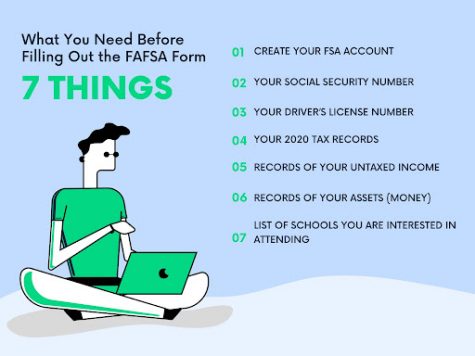The new enhancements to the online FAFSA form include a visual update which is similar to the look and uses of the studentaid.gov website. Users will be able to select their role before entering the FAFSA form. These roles include student, parent, or preparer of the document.
The financial aid toolkit provides information and charts to help navigate applicants on their FAFSA process. If you’re feeling anxious about filling out this form, refer to their 2022-2023 FAFSA preview presentation in a PowerPoint form which includes a walkthrough of how to navigate the website.
The U.S. Department of Education also urges applicants to create a Federal Student Aid ID also referred to as the FSA ID. This will be a username and password used to log into the application. This login should not be shared with anyone, as FAFSA holds critical information about you. In the case that you forget your password, make sure to include a verified email or phone number on your account so you’ll have an easier time logging back in.
For a quicker FAFSA process, the Internal Revenue Service Data Retrieval Tool (IRS DRT) transfers student and parents tax information into the form automatically. Some users may not be able to use this tool for the reasons listed by the site below.
- The person indicated that he or she had not filed taxes.
- The person’s marriage date is after the end of the year for which tax information is being reported.
- The person filed a non-U.S. tax form.
- The person is married and filed as head of household or married filing separately.
- Neither married parent entered a valid Social Security number.
- Both married parents (or the only parent reported on the FAFSA form) entered all zeroes for the Social Security number.
For details and FAQs about the IRS DRT, refer to StudentAid.gov/irsdrt.
What happened with the drug convictions question on FAFSA?
While filling out the FAFSA form, the questioning of drug convictions still holds. However, it will not affect a student’s federal aid eligibility. The website states “If the answer is yes, students will be provided a worksheet.” It’s encouraged for those applying to fill out the worksheet correctly.
What is Selective Service?
FAFSA has also removed the question of registration status with Selective Service. Question 22 asks the applicant “Do you want us to register you with the Selective Service System?” on the FAFSA form. This question means that if you are a male between the ages of 18-25 and are not registered with the Selective Service System (SSS) and answer “Yes” the SSS will register you. This requirement is applied to any person that is assigned the sex of male at birth. The SSS is the military draft of men during a crisis.
“It’s important to know that even though he is registered, a man will not automatically be inducted into the military. In a crisis requiring a draft, men would be called in a sequence determined by random lottery number and year of birth. Then, they would be examined for mental, physical, and moral fitness by the military before being deferred or exempted from military service or inducted into the Armed Forces.” The SSS website states.
What if a student does not have their parent’s information?
The application asks students whether they are filling out their FAFSA form without access to parent’s information. In this circumstance there are two options listed on the financial aid toolkit guide:
- If the student indicates that he or she has special circumstances such as having left home due to an abusive situation, the myStudentAid mobile app and fafsa.gov allow the student to submit the application without entering data about the parents. The student’s application will not be processed, and the student must contact the financial aid administrator at the school he or she plans to attend. The financial aid administrator will ask for additional information to determine whether the student can be considered independent.
- If the student indicates that the parent refuses to provide information on the FAFSA form and no longer supports the student, federal law allows the student to submit the application without parent information and—after review by the financial aid administrator at the student’s chosen school—potentially to receive only a Direct Unsubsidized Loan. The student must follow up with the financial aid administrator to find out what to do next to receive the loan.

The financial aid process is a long one so be prepared as much as you can. Ensure that you have all the documents you need, create that FSA ID account, and have a list of schools you are attending or plan to attend for the 2022-23 year. If you’re filing with your parents make sure to have their tax forms and social security numbers as well. Schedule for when you’d want to sit down and file the FAFSA form and try not to rush.
If you have questions, refer to your financial advisor, reach out to the UNF Department of Financial Aid, or visit the studentaid.gov website.
___
For more information or news tips, or if you see an error in this story or have any compliments or concerns, contact editor@unfspinnaker.com.
















